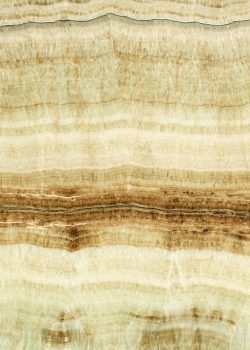ABOUT
When it comes to natural stones that captivate the human imagination, onyx stands in a league of its own. This natural stone has been revered for generations as a symbol of opulence and elegance due to its mesmerizing swirls of colour and distinctive translucence. The name finds its roots in the Greek term ‘ὄνυξ’ or ‘onyx’ which means a ‘claw’ or ‘fingernail’ as sometimes, the stone’s pink with white streaks seemed to resemble fingernails.
Onyx is usually formed in caves or bedrock openings over thousands of years from water accumulation and gradually evaporation, leaving behind layers of minerals. The banding pattern seen in onyx is a result of variations in mineral content and environmental conditions during its formation.
It can also be created through the gradual deposition of silica-rich solutions within rock cavities, followed by the evaporation of these solutions, leading to the crystallization of silica layers, particularly chalcedony (a mixture of quartz and morganite). The unique banding pattern in onyx is believed to be a consequence of alterations in the concentration and composition of these silica-rich solutions during the deposition process.
This stone held significant importance and great popular in civilizations of Ancient Rome and Egypt. In Ancient Rome, soldiers wore onyx as amulets to war that featured carvings of Mars, the God of War, in the belief that it would instill them with courage. Similarly, in ancient Egypt, onyx was attributed to having protective properties, leading to its use in the creation of amulets and so on. It was also used to craft bowls and other pottery items.







CHARACTERISTICS AND BENEFITS
Composition: It consists of the mineral calcite.
Hardness and Colours: Onyx score from a 6.5 to 7 on Mohs Hardness scale. It is available in a various colours such as honey yellow, orange, green, pink, black, white, grey, blue and more. It has rich underlying textures.
Application: Onyx can be used in various ways like bar tops, backsplash, desks, vanity, accent tiles/walls, basins, lighting fixtures, or tabletops.
Translucent: As onyx is translucent, they radiate light. Hence, they can be backlit anywhere, presenting various design possibilities and creating exotic and stunning looks.
Weight: Compared to other stones, onyx weigh relatively lighter. This makes it easier to use onyx for more innovative purposes.
Long Lasting: With proper maintenance, onyx surfaces or walls can last for generations.
Maintenance: One does not have to get harsh chemicals such as acid-based cleansers to clean as they might etch the surface. Mild-soap cleansers are best to clean onyx surfaces. However, it should be done with soft brushes to avoid abrasions.
DISADVANTAGES
Kitchen countertops: Using onyx for kitchen countertops is discouraged due to its susceptibility to staining. It can easily become stained when exposed to substances like lemon juice or vinegar. Additionally, cutting and chopping on the stone’s surface can result in scratches. It is also vulnerable to abrasions.
Maintenance: While maintain onyx may appear straightforward, it demands regular care. The stone requires periodic maintenance and sealing. It’s also crucial to shield onyx from heat sources, such as direct sunlight and stovetops, as it has a tendency to expand when subjected to high temperatures. Prolonged exposure can even result in cracks, potentially compromising the stone’s integrity over time.
WHY IS IT USED IN ARCHITECTURE AND DESIGN
Onyx is a rare and exotic stone that can radiate light, setting it apart different from other natural stones. Hence, its ability to emanate light, coupled with its unique patterns, has propelled onyx into the spotlight as a choice material for crafting luxurious statement pieces that redefine aesthetics. It can also be installed without any backlighting. Examples where onyx can be used include, bathroom vanity, luxurious spas, fitness centers, lobby décor, entrance foyers, mirror walls, lavish bathrooms and beyond.
Its other characteristics and benefits above, make it a popular choice. Onyx can further be toughened and strengthened by using mesh, resin or fibreglass backing. Additionally, various lights can enable the same onyx slab to look differently, offering endless possibilities for creative use and design innovation. With its enchanting luminosity and adaptability, onyx continues to push the boundaries of luxury and sophistication.
For more details log on our website : www.alasalmarbles.com or write us email : info@alasalmarbles.com
Follow our social media for regular updates...
Tag : Neolith, Cladding, Natural stone, Cladding materials, Selecting the best cladding material, Exterior, cladding, High-rise buildings, Most popular cladding material, Limestone, Travertine, Current trend in cladding, Quartzite, Choose a marble for kitchen top, Kitchen Islands, Natural marble top, Marble Countertop, Highly durable stone, Preferred options for the kitchen tops, Granite Counter tops, Cleaning the granite counters, Kitchen countertop, Best kitchen countertop, Marble, Marble, kitchen tops, Natural stones, Designing your kitchen, Granite, Caesarstone, Sintered stones, Marble and granite suppliers in UAE, Kitchen Counter, How to select kitchen counter, Quartz Slabs, Slate, Countertop options, Quartzite countertops, Cleaning quartzite countertops, Sintered Stone, Kitchen surface, Advantage of Neolith, Countertop designs, Quartz countertops, Budget friendly, kitchen countertops, Feature wall, Natural stone cladding, Granite cladding, AL ASAL MARBLE, Adhesive, Marble adhesive, Floor, Flooring, Commercial, Projects, Projects, Stones, Stones, Internal, External, Walls, Flexible, Countertops, Wall cladding, Engineered stone, Stone adhesive, Marble fixing, Marble flooring, Waterproofing, Sealing, Sealant, Marble cleaning, Marble suppliers in UAE, Marble manufacturer, Stains in marble, Marble sealer, Leading marble company in UAE, Best Marble company, Marble protection






